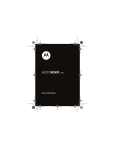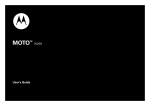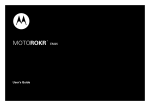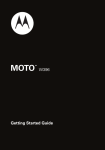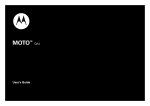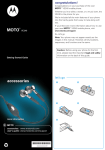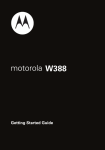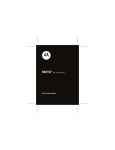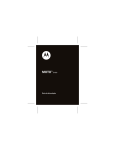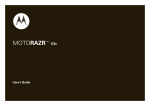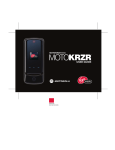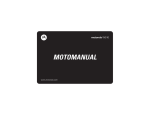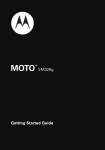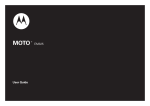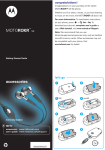Download Motorola 57976500400 Network Router User Manual
Transcript
MOTOROKR ™ EM25 Getting Started Guide congratulations! contents The MOTOROKR™ EM25 does it all. Use the music player to listen to the newest, hottest songs. Or, take photos and send them to your friends. All this while you’re still connected—take or make calls or exchange messages. your phone . . . . . . . . . . . . . . . . . . . . . . . . . . . . . . . . . 3 menu map . . . . . . . . . . . . . . . . . . . . . . . . . . . . . . . . . . 4 let’s go . . . . . . . . . . . . . . . . . . . . . . . . . . . . . . . . . . . . . 5 basics. . . . . . . . . . . . . . . . . . . . . . . . . . . . . . . . . . . . . . 6 calls . . . . . . . . . . . . . . . . . . . . . . . . . . . . . . . . . . . . . . . 7 contacts. . . . . . . . . . . . . . . . . . . . . . . . . . . . . . . . . . . . 10 customize . . . . . . . . . . . . . . . . . . . . . . . . . . . . . . . . . . 11 shortcuts . . . . . . . . . . . . . . . . . . . . . . . . . . . . . . . . . . 13 messages . . . . . . . . . . . . . . . . . . . . . . . . . . . . . . . . . 14 status indicators . . . . . . . . . . . . . . . . . . . . . . . . . . . . 16 photo . . . . . . . . . . . . . . . . . . . . . . . . . . . . . . . . . . . . . . 17 set up music . . . . . . . . . . . . . . . . . . . . . . . . . . . . . . . 18 get music. . . . . . . . . . . . . . . . . . . . . . . . . . . . . . . . . . 21 play music . . . . . . . . . . . . . . . . . . . . . . . . . . . . . . . . . 25 FM radio . . . . . . . . . . . . . . . . . . . . . . . . . . . . . . . . . . 30 Bluetooth® . . . . . . . . . . . . . . . . . . . . . . . . . . . . . . . . 31 personal organizer . . . . . . . . . . . . . . . . . . . . . . . . . . 33 USB & memory card . . . . . . . . . . . . . . . . . . . . . . . . 35 web access . . . . . . . . . . . . . . . . . . . . . . . . . . . . . . . . 37 security . . . . . . . . . . . . . . . . . . . . . . . . . . . . . . . . . . . 38 We’ve crammed all of the main features of your phone into this handy guide, and in a matter of minutes we’ll show you just how easy your phone is to use. So go on, check it out. Browse the menus and press Options to see more. You may be surprised at what you discover. If you’d like even more information about how to use your new ROKR EM25, visit www.motorola.com/consumer/ support. Caution: Before using your phone for the first time, please read the important legal and safety information at the back of this guide (page 39). 1 2 menu map your phone L q your phone menu map Navigation Key Scroll up, down, left, right or press centre to select. Left Soft Key Volume Keys Right Soft Key Clear Key Music Key Power/End Key g Send Key Low Battery Charging Indicator 3.5 mm Headset Port Note: Mini USB headsets are not supported. Mini USB Connector Charge and connect to PC. m Microphone 3 T Games & Apps 1 WebAccess Phonebook Recent Calls • Received Calls • Dialed Calls • Notepad • Erase All • Call Time • Call Cost * • GPRS Data Counter • GPRS Connection Time Messages • Create Message • Message Inbox • Outbox • Drafts • Voicemail • Browser Msgs • Quick Notes • MMS Templates Tools • Calculator • Shortcuts • Chat * • SIM Toolkit * • Calendar • Lantern • Alarm Clock • • • • • • j u Browser Web Shortcuts Go To URL History Web Sessions Web Settings Multimedia • Camera • Music Library • Pictures • Voice Notes • FM Radio • My Picture Settings * Network Dependent This is the standard main menu layout. Your phone’s menu may be different. 4 let’s go basics here’s a few essential basics let’s go basics 2 1 turn it on & off 3 SIM Press and hold P for a few seconds to turn the phone on/off. 4 menu navigation 5 microSD Press the center key s to open the Main Menu. 6 Press the navigation key S up, down, right or left to highlight a menu option. remove the battery 7 Press s or Select (left soft key) to select the highlighted option. Low Battery Charging Indicator Lit until display powers on 4H 5 6 calls calls emergency calls it’s good to talk calls make a call To call an emergency number, enter the emergency number and press N. Enter a number and press N. answer a call When your phone rings or vibrates, press N. end a call Press P. From the home screen, press N to see a list of recently dialed calls. 2 Scroll to the entry you want to call and press N. Emergency numbers vary by country. Your phone’s pre-programmed emergency number(s) may not work in all locations, and sometimes an emergency call cannot be placed due to network, environmental, or interference issues. go handsfree redial a number 1 Your service provider programs emergency phone numbers, (such as 112 or 911), that you can call under any circumstances, even when your phone is locked. To turn the speaker on or off during a call, press Spkr on. Note: You can also use an optional 3.5 mm wired headset to go handsfree. 7 8 calls contacts in-call menu met someone new? save their number contacts During a call you can access the in-call menu by pressing Options: save a contact 1 Enter the number on the home screen and press Save. • My Tel. Number - view your phone number. • Hold or Unhold - hold the call. • Mute or Unmute - silence your microphone. • Spkrphone On or Off - turn speakerphone on or off. • Use Bluetooth or Use Handset - turn Bluetooth on or off. • Phonebook - access list of contacts. • New Call - make another call. • Dialed Calls - view recently dialed calls. send a contact • Received Calls - view recently received calls. • Messages - access your messages menu. • Calendar - view calendar. • Dialing prefix - enter a character as a prefix to dialing. 1 2 3 2 Enter the contact details and press Save again. call a contact 1 2 3 9 10 Press s > L Phonebook. Scroll through the list to highlight the contact. Press N. Scroll through the list to highlight the contact. Press Options > Send Business Card > OK. Select the message type, the person you are sending the contact to, and press Send. customize customize go ahead, add your personal touch... set ringtone & volume home screen shortcuts There are times when you want to hear your ringtone, and there are times when you don’t. Find it: s > u Settings > b Personalize > Home Screen Find it: s > u Settings > N Ring Styles customize > Home Keys Choose from the pre-programmed styles, including Vibrating and Silent. options Show Icons Up, Down, Left, Right set slide tone Show or hide the home screen shortcut icons. Select a tone to play every time you slide your phone: Choose the features that open when you press the navigation key (S) up, down, left, or right in the home screen. Find it: s > u Settings > b Personalize > Slide Tone anykey answer Answer your phone by pressing any key on your keypad. set wallpaper, screen saver & color style Find it: s > u Settings > g In-Call Setup > Anykey Answer Change the wallpaper, screen saver and color style to set the look and feel of your phone’s display. Find it: s > u Settings > b Personalize > Wallpaper, Screen Saver or Color Style 11 12 shortcuts messages a few ways to make your phone easier to use sometimes it’s better 2 say it in a message shortcuts messages create & send a message options take a photo Press s > j Multimedia > Camera. Press s to take a photo. play music Press [. FM radio Press and hold [. silence ringtone Press the up or down volume key when your phone rings. quick text Use quick text to access the Message screen with a single key press. To set quick text on your home screen, press s > u Settings > b Personalize > Home Screen > Home keys > key > Quick TEXT. voicemail Press and hold 1. dialed calls Press N. change ring style Press and hold #. 1 2 3 4 Press s > g Messages > Create Message. Select a message type and enter the message text (see page 15). To insert a picture, sound, or other object, press Options > Insert or Insert Object. When you finish the message, press Send. Choose one or more people to send to and press Send. receive a message Press View to read the message immediately, or save it in your message inbox for viewing later. Find it: s > g Messages > Message Inbox voicemail When you receive a voicemail message, your phone shows an indicator and New Voice Message. Press Call to call voicemail and follow the prompts. 13 14 status indicators messages enter text to keep you updated, whatever way you look at it status indicators • iTAP™ (j) - Combines your single key presses and predicts each word as you enter it. If the word is not correct, press S right or left to scroll through the possible combinations. Signal Strength GPRS Active Changes to when connected. Battery Level WAP Active Roaming Active 2008/12/12 Ring Style & & • tap (abc) - Standard method for entering text on your phone. Regular Tap method cycles through the letters and numbers of the key you press. & To assign Primary and Secondary entry modes, press Options > Input Setup > Primary Setup or Secondary Setup from the text entry screen: Status indicators can appear across the top of the home screen (your phone’s home screen may be different than the one shown). & When you are in a text entry screen, press # to switch text entry modes (Primary, Secondary, Numeric and Symbol). Shortcut 10:51am Menu New Message Active Line Bluetooth Press * to enter a space and move on the next word. Press 1 to enter punctuation. Press 0 to switch capitalization modes if you need to (although, in most cases, this is done for you). Press S up to accept and enter the suggested word. 15 16 photo set up music photo see it, capture it, send it! set up music take & send a photo what music transfer tools do I need? 1 when music is what you need... Press s > j Multimedia > Camera. To put music on your computer and then load it on your phone, you need: Storage Location • A Microsoft™ Windows™ XP™ or Windows Vista™ PC • USB data cable (may be sold separately) Resolution Zoom 1x Options do I need a memory card? Back Note: Before taking your photo, you can press Options to open the camera menu. From here you can access features, such as Auto-Timed Capture, Camera Setup and Free Space. 2 3 Press s to take the photo. Your phone does have around 5 MB of internal memory, but it also supports removable microSD memory cards with up to 2 GB capacity, allowing you to store much more data. Note: Motorola approved SanDisk cards are recommended for cards greater than 1 GB. See “USB & memory card” on page 35 for more information on memory cards. Press Send to send the photo in a message. Press s to save the photo, or Options to store or Discard. 17 18 set up music set up music what music file formats can I play? what headphones can I use? Your phone can play many types of files: MP3, AAC, AMR, and WAV. Your phone has a 3.5 mm headset jack for wired stereo listening. Or, go wireless and use optional Bluetooth stereo headphones to listen to your music (see “use a headset or car kit” on page 31 for more information). do I need a USB cable? To load music from a computer to your phone, you must use a USB data cable, which may be sold separately from your phone. Note: If you have a removable memory card and a memory card reader, you don’t need a cable. See “using a memory card reader” on page 23. 19 Note: When listening to music using a Bluetooth stereo device (headset, car stereo, etc.), use the volume control keys on the device to increase/decrease music volume. 20 get music get music load your phone with your favorite songs load music rip songs from a CD Transfer files from a PC to a removable memory card. Well, not literally. If you’re new to music, this means transferring songs from an audio CD to your PC. To do this, you need Windows Media Player version 11 or later. You can download Windows Media Player from www.microsoft.com. Note: Your phone does not support DRM protected music files. The unauthorized copying of copyrighted materials is contrary to the provisions of the Copyright Laws of the United States and other countries. This device is intended solely for copying non-copyrighted materials, materials in which you own the copyright, or materials which you are authorized or legally permitted to copy. If you are uncertain about your right to copy any material, please contact your legal advisor. get music 1 2 On your PC, launch Windows Media Player. Insert an audio CD into your PC’s CD ROM drive. Note: Make sure you change the format to MP3 or AAC in the Rip Settings. 3 4 PC to phone In the Windows Media Player window, click on the “Rip” tab. Highlight the songs you want to import and click “Rip Music.“ Got a USB data cable? Good, let’s start loading your music onto your phone: 1 2 The songs are imported to the Windows Media Player Library. Next, transfer the songs from your PC to your phone. 3 21 22 Make sure that u Settings > æ USB is set to USB Disk. With a memory card inserted and your phone in the home screen, insert the USB cable in your phone and your Windows PC. Now you’ve connected, use USB drag and drop to copy your music. get music get music 1 USB drag and drop 1 Use the “My Computer” window to find “Removable Disk”. Note: When your phone is plugged into a PC and is being used as a mass storage device, it cannot be used for anything else. To restore the phone to normal use, disconnect it from the PC. 2 3 2 On your Windows PC, open “My Computer” and click on “Removable Disk” to access your phone’s memory card. In the “Removable Disk” window, create one or more folders for the files you will copy onto the memory card. Warning: The “mobile\Picture” folder is used by your phone. Do not delete this folder. Drag and drop your music anywhere onto the memory card. 3 Note: A file name (including the path) must be less than 255 characters. 4 When you’re done, use the Safely Remove Hardware feature to finish. Drag and drop your music anywhere onto the memory card. When you’re finished, disconnect by clicking on the “Safely Remove Hardware” icon in the system tray on your PC screen, selecting “USB Mass Storage Device,” and selecting “Stop.” using a memory card reader To transfer files using a memory card reader, insert your memory card into the card reader (you may first need to insert the card into an adapter that fits into the card reader). Insert the card reader into an available USB port on your PC. 23 24 play music play music listen to your favorite tunes... Note: To refresh your music library, press, Options > Refresh. play music Find it: s > j Multimedia > Music Library Note: Your phone may not play MP3 files that have a bit rate higher than 320 kbps. If you try to download or play one of these files, your phone may display an error message or ask you to delete the file. From the Music Library, open one of these options: music player controls functions scroll through song list Before music playback, press S up or down. play Press s, or Options > Play. pause/resume Press s. fast forward Press & hold S right. next/previous Press & release S right/left. options Now Playing Select the song that is currently playing. All Songs Select a song to show or play songs. Playlists Play and manage your playlists. song Artists Select an artist to show or play their songs. rewind Press & hold S left. Albums Select an album to show or play its songs. hide Press Options > Hide to minimize the music player Genres Select a genre of music to show or play its songs. turn off Press P. 25 26 play music play music Note: Press the up/down side volume keys to change the volume of the song playing. When listening to music using a Bluetooth stereo device (headset, car stereo, etc.), use the volume control keys on the device to increase/decrease music volume. option Select Multiple To Select multiple songs to Add to Playlist, Delete, Move or Copy. Properties View the details for a song playlists Music Setup Set up music preferences. Find it: s > j Multimedia > Music Library > Playlists View Free Space View the storage space available. • To create a new playlist, select Create new playlist. • To play a playlist, scroll to the playlist and press Options > Play. music playlist options option wake up music player While the music player is active, your phone conserves battery power by turning off the display and keypad backlights. To turn display and backlights back on, press any key. Play Play a song or playlist. Add songs Add a song/s to an existing playlist. Send Send a song using a message or Bluetooth. Manage Delete, Move or Copy a song. 27 28 play music FM radio music player tips FM radio If you receive a call while playing music, the music pauses. You can Ignore the call and send the caller to voicemail or Answer the call. Playing resumes when you end the call. To use the FM Radio you need to connect a stereo headset to the 3.5 mm headset jack. listen to your favorite news or music programme To hide your music player while a song is playing, press Options > Hide. If the music player is hidden, you can use other phone features. Using applications, such as games or FM radio, turns the music player off. • Press and hold [ to launch the FM Radio. • Press S up or down to change the frequency. • Press S left or right to scan for preset radio stations. • Press the up or down volume keys on the side of the phone to adjust the volume. • Press s to mute the radio. use the radio presets 1 2 3 29 30 Tune in the desired frequency by pressing S up or down, or press Options > Scan to scan for all available radio stations. Press and hold a number key to save that number as the preset. To select the preset station, press the keypad number. Bluetooth® Bluetooth® lose the wires and go wireless If Bluetooth is switched off, you will be prompted to turn it on. Your phone now lists the devices it finds within range: Bluetooth® Your phone supports Bluetooth wireless connections with audio devices, such as a handsfree headset or music system. 1 Note: The use of wireless phones while driving may cause distraction. Discontinue a call if you can’t concentrate on driving. Additionally, the use of wireless devices and their accessories may be prohibited or restricted in certain areas. Always obey the laws and regulations on the use of these products. For maximum Bluetooth security, you should always connect Bluetooth devices in a safe, private environment. use a headset or car kit Before you try to connect your phone with a headset, car kit or other audio device, make sure the device is on and ready in pairing or bonding mode (see the user’s guide for the device). 2 3 Scroll to a device in the list and press the center key s. If necessary, press Yes or OK to connect to the device. If necessary, enter the device passkey (such as 0000) and press OK. When your phone is connected, the Bluetooth indicator O is highlighted in the status bar. Shortcut: When your phone’s Bluetooth power is on, your phone can automatically connect to a handsfree device you have used before. Just turn on the device, or move it near the phone. If the device doesn’t connect, turn it off and back on. Find it: s > u Settings > E Bluetooth Link > Add Audio Device 31 32 personal organizer personal organizer stay on top of things with these handy features calculator add & view calendar event Find it: s > m Tools > Calculator Find it: s > m Tools > Calendar Tip: To convert currency, enter your currency figure and press Options and select Exchange Rate. Select Convert to calculate your new currency figure. personal organizer Scroll to the desired day and press s, then scroll to [Add New] and press Select to add, or scroll to the event and press Select to view. Note: When an event reminder occurs, press s to view it. Press Exit to dismiss it. set alarm Find it: s > m Tools > Alarm Clock To set the FM radio as an alarm, press [New Alarm]. Scroll to FM Radio and press S right, to select a preset frequency. Note: Alarm defaults to the ringtone if a headset is not plugged in. 33 34 USB & memory card USB & memory card 3 connect your phone and PC, then drag & drop USB & memory card format You need to format a memory card, using the phone, before using it for the first time. This creates the necessary folders and ensures your phone can read the contents of the card. Your phone will prompt you if you need to format your memory card. Note: When your phone is plugged into a PC and is being used as a mass storage device, it cannot be used for anything else. To restore the phone to normal use, disconnect it from the PC. 4 Note: To manually format the memory card press s > u Settings > i Initial Setup > Format memory card. Caution: Formatting the memory card erases all content on the card. drag & drop 1 2 Make sure that u Settings > Note: Your phone supports Microsoft Windows XP and Windows Vista. Other operating systems may not be compatible with your phone. 35 Drag and drop your music, photos and other stuff that you want to copy. Picture files must be copied to the “mobile\Picture” folder. Music files can be copied anywhere onto the memory card. Note: To find your picture files on your phone press s > j Multimedia > Pictures, then press Options > Switch Storage > Memory Card æ USB is set to USB Disk. With a memory card inserted and your phone in the home screen, insert the USB cable in your phone and your Windows PC. Use the “My Computer” window to find “Removable Device” (sometimes shown as “NO NAME”). A music or picture file name (including the path) must be less than 255 characters. 5 Use the Safely Remove Hardware feature to finish. Note: To charge your phone from a PC, please download the USB charging driver on to your PC, at www.motorola.com/consumer/support. 36 web access security you don’t need a PC, surf the web with your phone web access Find it: s > 1 WebAccess keep your phone secure security codes & passwords feature Your phone’s four-digit unlock code is originally set to 1234 or to the last four digits of your phone number. open the Web browser To change a code or password: s> 1 WebAccess > Browser Find it: s > u Settings > N Security > New Passwords go to a Web page s> 1 WebAccess > Go To URL lock & unlock phone download objects from a Web page You can lock your phone to keep others from using it. s> 1 WebAccess > Browser > page, Options > Save Picture Find it: s > u Settings > N Security > Phone Lock > Lock Now or Automatic Lock create and access Web page shortcuts Enter the four-digit unlock code and press OK. Your phone first displays Phone Locked, and then shows Phone Lock Code until the next time you unlock your phone. s> 1 WebAccess > Web Shortcuts To unlock your phone, enter your four-digit code and press OK. 37 38 Legal and Safety Information Legal and Safety Information battery use & safety IMPORTANT: HANDLE AND STORE BATTERIES PROPERLY TO AVOID INJURY OR DAMAGE. Most battery issues arise from improper handling of batteries, and particularly from the continued use of damaged batteries. DON’Ts • Don’t disassemble, crush, puncture, shred, or otherwise attempt to change the form of your battery. • Don’t let the phone or battery come in contact with water. Water can get into the phone’s circuits, leading to corrosion. If the phone and/or battery get wet, have them checked by your carrier or contact Motorola, even if they appear to be working properly. • Don’t allow the battery to touch metal objects. If metal objects, such as jewelry, stay in prolonged contact with the battery contact points, the battery could become very hot. • Don’t place your battery near a heat source. Excessive heat can damage the phone or the battery. High temperatures can cause the battery to swell, leak, or malfunction. Therefore: • Do not dry a wet or damp battery with an appliance or heat source, such as a hair dryer or microwave oven. • Avoid leaving your phone in your car in high temperatures. DOs • Do avoid dropping the battery or phone. Dropping these items, especially on a hard surface, can potentially cause damage. 39 Disposal: Promptly dispose of used batteries in accordance with local regulations. Contact your local recycling center or national recycling organizations for more information on how to dispose of batteries. Warning: Never dispose of batteries in a fire because they may explode. service & repairs If you have questions or need assistance, we’re here to help. Go to www.motorola.com/support, where you can select from a number of customer care options. You can also contact the Motorola Customer Support Center at 1-800-331-6456 (United States), 1-888-390-6456 (TTY/ TDD United States for hearing impaired), or 1-800-461-4575 (Canada). Specific Absorption Rate Data SAR Data This model wireless phone meets the government’s requirements for exposure to radio waves. Your wireless phone is a radio transmitter and receiver. It is designed and manufactured not to exceed limits for exposure to radio frequency (RF) energy set by the Federal Communications Commission (FCC) of the U.S. Government and by the Canadian regulatory authorities. These limits are part of comprehensive guidelines and establish permitted levels of RF energy for the general population. The guidelines are based on standards that were developed by independent scientific organizations through periodic and thorough evaluation of scientific studies. The standards include a substantial safety margin designed to assure the safety of all persons, regardless of age or health. The exposure standard for wireless mobile phones employs a unit of measurement known as the Specific Absorption Rate, or SAR. The SAR limit set by the FCC and by the Canadian regulatory authorities is 1.6 W/kg.1 Tests for SAR are conducted using standard operating 41 • Do contact your service provider or Motorola if your phone or battery has been damaged from dropping or high temperatures. IMPORTANT: USE MOTOROLA ORIGINAL PRODUCTS FOR QUALITY ASSURANCE AND SAFEGUARDS. To aid consumers in identifying authentic Motorola batteries from non-original or counterfeit batteries (that may not have adequate safety protection), Motorola provides holograms on its batteries. Consumers should confirm that any battery they purchase has a “Motorola Original” hologram. Motorola recommends you always use Motorola-branded batteries and chargers. Motorola mobile devices are designed to work with Motorola batteries. If you see a message on your display such as Invalid Battery or Unable to Charge, take the following steps: • Remove the battery and inspect it to confirm that it has a “Motorola Original” hologram; • If there is no hologram, the battery is not a Motorola battery; • If there is a hologram, replace the battery and retry charging it; • If the message remains, contact a Motorola Authorized Service Center. Important: Motorola’s warranty does not cover damage to the phone caused by non-Motorola batteries and/or chargers. Warning: Use of a non-Motorola battery or charger may present a risk of fire, explosion, leakage, or other hazard. PROPER AND SAFE BATTERY DISPOSAL AND RECYCLING Proper battery disposal is not only important for safety, it benefits the environment. Consumers may recycle their used batteries in many retail or service provider locations. Additional information on proper disposal and recycling may be found on the Web: • www.motorola.com/recycling • www.rbrc.org/call2recycle/ (in English only) 40 positions accepted by the FCC and by Industry Canada with the phone transmitting at its highest certified power level in all tested frequency bands. Although the SAR is determined at the highest certified power level, the actual SAR level of the phone while operating can be well below the maximum value. This is because the phone is designed to operate at multiple power levels so as to use only the power required to reach the network. In general, the closer you are to a wireless base station, the lower the power output. Before a phone model is available for sale to the public in the U.S. and Canada, it must be tested and certified to the FCC and Industry Canada that it does not exceed the limit established by each government for safe exposure. The tests are performed in positions and locations (e.g., at the ear and worn on the body) reported to the FCC and available for review by Industry Canada. The highest SAR value for this model phone when tested for use at the ear is 1,01 W/ kg, and when worn on the body, as described in this user guide, is 0,61 W/kg. (Body-worn measurements differ among phone models, depending upon available accessories and regulatory requirements).2 While there may be differences between the SAR levels of various phones and at various positions, they all meet the governmental requirements for safe exposure. Please note that improvements to this product model could cause differences in the SAR value for later products; in all cases, products are designed to be within the guidelines. Additional information on Specific Absorption Rates (SAR) can be found on the Cellular Telecommunications & Internet Association (CTIA) Web site: http://www.phonefacts.net or the Canadian Wireless Telecommunications Association (CWTA) Web site: 42 http://www.cwta.ca 1. In the United States and Canada, the SAR limit for mobile phones used by the public is 1.6 watts/kg (W/kg) averaged over one gram of tissue. The standard incorporates a substantial margin of safety to give additional protection for the public and to account for any variations in measurements. 2. The SAR information includes the Motorola testing protocol, assessment procedure, and measurement uncertainty range for this product. While there may be differences between the SAR levels of various phones and at various positions, they all meet the governmental requirements for safe exposure. Please note that improvements to this product model could cause differences in the SAR value for later products; in all cases, products are designed to be within the guidelines. The World Health Organization has stated that present scientific information does not indicate the need for any special precautions for the use of mobile devices. They note that if you want to reduce your exposure then you can do so by limiting the length of calls or using a “handsfree” device to keep the mobile phone away from the head and body. Specific Absorption Rate Data Additional Information can be found on the websites of the World Health Organization (http://www.who.int/emf) or Motorola, Inc. (http://www.motorola.com/rfhealth). SAR Data This model meets international guidelines for exposure to radio waves. Your mobile device is a radio transmitter and receiver. It is designed not to exceed the limits for exposure to radio waves recommended by international guidelines. These guidelines were developed by the independent scientific organization ICNIRP and include safety margins designed to assure the protection of all persons, regardless of age and health. The guidelines use a unit of measurement known as the Specific Absorption Rate, or SAR. The ICNIRP SAR limit for mobile devices used by the general public is 2 W/kg and the highest SAR value for this device when tested at the ear is 0,62 W/kg (850/1900 MHz); 0,67 W/kg (900/1800 MHz) .1 As mobile devices offer a range of functions, they can be used in other positions, such as on the body as described in this user’s guide.2 In this case, the highest tested SAR value is 0,43 W/kg (850/1900 MHz); 0,52 W/kg (900/1800 Mhz) .1 1. The tests are carried out in accordance with international guidelines for testing. The limit incorporates a substantial margin for safety to give additional protection for the public and to account for any variations in measurements. Additional related information includes the Motorola testing protocol, assessment procedure, and measurement uncertainty range for this product. 2. Please see the Safety and General Information section about body worn operation. European Union Directives Conformance Statement Hereby, Motorola declares that this product is in compliance with: EU Conformance • The essential requirements and other relevant provisions of Directive 1999/5/EC • All other relevant EU Directives As SAR is measured utilizing the device’s highest transmitting power, the actual SAR of this device while operating is typically below that indicated above. This is due to automatic changes to the power level of the device to ensure it only uses the minimum level required to reach the network. 43 0168 Product Approval Number The above gives an example of a typical Product Approval Number. You can view your product’s Declaration of Conformity (DoC) to Directive 1999/5/EC (to R&TTE Directive) at www.motorola.com/rtte. To find your DoC, enter the Product Approval Number from your product’s label in the “Search” bar on the Web site. Safety and General Information Safety Information This section contains important information on the safe and efficient operation of your mobile device. Read this information before using your mobile device. Exposure to Radio Frequency (RF) Energy Your mobile device contains a transmitter and receiver. When it is ON, it receives and transmits RF energy. When you communicate with your mobile device, the system handling your call controls the power level at which your mobile device transmits. Your Motorola mobile device is designed to comply with local regulatory requirements in your country concerning exposure of human beings to RF energy. 45 44 Operational Precautions For optimal mobile device performance, and to be sure that human exposure to RF energy does not exceed the guidelines set forth in the relevant standards, always follow these instructions and precautions. Product Operation When placing or receiving a phone call, hold your mobile device just like you would a landline phone. If you wear the mobile device on your body, always place the mobile device in a Motorola-supplied or approved clip, holder, holster, case, or body harness. If you do not use a body-worn accessory supplied or approved by Motorola—or if you hang your mobile device from a lanyard around your neck—keep the mobile device and its antenna at least 2.5 centimeters (1 inch) from your body when transmitting. Using accessories not supplied or approved by Motorola may cause your mobile device to exceed RF energy exposure guidelines. For a list of Motorola-supplied or approved accessories, visit our Web site at: www.motorola.com. RF Energy Interference/Compatibility Nearly every electronic device is subject to RF energy interference from external sources if inadequately shielded, designed, or otherwise configured for RF energy compatibility. In some circumstances your mobile device may cause interference with other devices. Follow Instructions to Avoid Interference Problems Turn off your mobile device in any location where posted notices instruct you to do so. In an aircraft, turn off your mobile device whenever instructed to do so by airline staff. If your mobile device offers an airplane mode or similar feature, consult airline staff about using it in flight. 46 Implantable Medical Devices If you have an implantable medical device, such as a pacemaker or defibrillator, consult your physician before using this mobile device. Persons with implantable medical devices should observe the following precautions: • ALWAYS keep the mobile device more than 20 centimeters (8 inches) from the implantable medical device when the mobile device is turned ON. • DO NOT carry the mobile device in the breast pocket. • Use the ear opposite the implantable medical device to minimize the potential for interference. • Turn OFF the mobile device immediately if you have any reason to suspect that interference is taking place. Read and follow the directions from the manufacturer of your implantable medical device. If you have any questions about using your mobile device with your implantable medical device, consult your healthcare provider. Driving Precautions The use of wireless phones while driving may cause distraction. Discontinue a call if you can’t concentrate on driving. Additionally, the use of wireless devices and their accessories may be prohibited or restricted in certain areas. Always obey the laws and regulations on the use of these products. Responsible driving practices can be found in the “Smart Practices While Driving” section in this guide (or separate guide). Operational Warnings Obey all posted signs when using mobile devices in public areas. Potentially Explosive Atmospheres Areas with potentially explosive atmospheres are often, but not always, posted and can include fueling areas, such as below decks on boats, fuel 47 Batteries & Chargers Caution: Improper treatment or use of batteries may present a danger of fire, explosion, leakage, or other hazard. For more information, see the “battery use & safety” section in this guide. Keep Your Mobile Device and Its Accessories Away From Small Children These products are not toys and may be hazardous to children. For example: • A choking hazard may exist for small, detachable parts. • Improper use could result in loud sounds, possibly causing hearing injury. • Improperly handled batteries could overheat and cause a burn. Glass Parts Some parts of your mobile device may be made of glass. This glass could break if the product is dropped on a hard surface or receives a substantial impact. If glass breaks, do not touch or attempt to remove. Stop using your mobile device until the glass is replaced by a qualified service center. Seizures/Blackouts Some people may be susceptible to epileptic seizures or blackouts when exposed to flashing lights, such as when playing video games. These may occur even if a person has never had a previous seizure or blackout. If you have experienced seizures or blackouts, or if you have a family history of such occurrences, please consult with your physician before playing video games or enabling a flashing-lights feature (if available) on your mobile device. Discontinue use and consult a physician if any of the following symptoms occur: convulsion, eye or muscle twitching, loss of awareness, involuntary movements, or disorientation. It is always a good idea to hold the screen 49 or chemical transfer or storage facilities, or areas where the air contains chemicals or particles, such as grain dust, or metal powders. When you are in such an area, turn off your mobile device, and do not remove, install, or charge batteries. In such areas, sparks can occur and cause an explosion or fire. Symbol Key Your battery, charger, or mobile device may contain symbols, defined as follows: Symbol 032374o Definition Important safety information follows. Do not dispose of your battery or mobile device in a fire. 032376o 032375o Your battery or mobile device may require recycling in accordance with local laws. Contact your local regulatory authorities for more information. Do not throw your battery or mobile device in the trash. Do not let your battery, charger, or mobile device get wet. Listening at full volume to music or voice through a headset may damage your hearing. 48 away from your eyes, leave the lights on in the room, take a 15-minute break every hour, and stop use if you are tired. Caution About High Volume Usage Warning: Exposure to loud noise from any source for extended periods of time may affect your hearing. The louder the volume sound level, the less time is required before your hearing could be affected. To protect your hearing: • Limit the amount of time you use headsets or headphones at high volume. • Avoid turning up the volume to block out noisy surroundings. • Turn the volume down if you can’t hear people speaking near you. If you experience hearing discomfort, including the sensation of pressure or fullness in your ears, ringing in your ears, or muffled speech, you should stop listening to the device through your headset or headphones and have your hearing checked. For more information about hearing, see our Web site at www.motorola.com/hearingsafety (in English only). Repetitive Motion When you repetitively perform actions such as pressing keys or entering finger-written characters, you may experience occasional discomfort in your hands, arms, shoulders, neck, or other parts of your body. If you continue to have discomfort during or after such use, stop use and see a physician. [Mar0108] 50 Use and Care FCC Notice to Users The following statement applies to all products that have received FCC approval. Applicable products bear the FCC logo, and/or an FCC ID in the format FCC-ID:xxxxxx on the product label. Motorola has not approved any changes or modifications to this device by the user. Any changes or modifications could void the user’s authority to operate the equipment. See 47 CFR Sec. 15.21. This device complies with part 15 of the FCC Rules. Operation is subject to the following two conditions: (1) This device may not cause harmful interference, and (2) this device must accept any interference received, including interference that may cause undesired operation. See 47 CFR Sec. 15.19(3). This equipment has been tested and found to comply with the limits for a Class B digital device, pursuant to part 15 of the FCC Rules. These limits are designed to provide reasonable protection against harmful interference in a residential installation. This equipment generates, uses and can radiate radio frequency energy and, if not installed and used in accordance with the instructions, may cause harmful interference to radio communications. However, there is no guarantee that interference will not occur in a particular installation. If this equipment does cause harmful interference to radio or television reception, which can be determined by turning the equipment off and on, the user is encouraged to try to correct the interference by one or more of the following measures: • Reorient or relocate the receiving antenna. • Increase the separation between the equipment and the receiver. • Connect the equipment to an outlet on a circuit different from that to which the receiver is connected. • Consult the dealer or an experienced radio/TV technician for help. FCC Notice Use and Care To care for your Motorola phone, please keep it away from: liquids of any kind Don’t expose your phone to water, rain, extreme humidity, sweat, or other moisture. If it does get wet, don’t try to accelerate drying with the use of an oven or dryer, as this may damage the phone. extreme heat or cold Avoid temperatures below 0°C/32°F or above 45°C/ 113°F. microwaves Don’t try to dry your phone in a microwave oven. dust and dirt Don’t expose your phone to dust, dirt, sand, food, or other inappropriate materials. cleaning solutions To clean your phone, use only a dry soft cloth. Don’t use alcohol or other cleaning solutions. the ground Don’t drop your phone. Latin America Warranty, except Mexico Latin America Warranty MOTOROLA INC. Subscribers/ Cellular Division Warranty (except Mexico) 51 Through its own service centers and/or its authorized service centers, Motorola provides a 1-year warranty that covers the cellular phone, all its parts and labor against any defect and operation as long as the “Product” has been operated and handled under normal conditions. The term of 1 year begins when the “Product” is purchased. Conditions For warranty service, return the “Product” and this warranty to the place of purchase or to any Motorola authorized service center. If additional information is needed, please contact any of our service centers: Motorola de México, S.A. Bosques Alisos No. 125 Bosques de las Lomas CP 05120 México, D.F. Telephone: 257-6700 Motorola de Brasil Rua Bandeira, Paulista 580 Sao Paulo, Brazil 05424-010 Telephone: 821-9991 Centro de Servicio Motorola de Colombia Diagonal 127A N. 17-64 Bogotá, Colombia Telephone: 615-5759 Telephone: 615-5769 Telephone: 216-1743 53 52 If the cellular phone has been installed in a vehicle, take the vehicle to the service center to analyze the equipment, or the installation on the vehicle. This warranty does not cover the installation of the cellular phone. Motorola Inc., through its own service centers and/or their authorized service centers, will repair or replace the cellular phone at no charge. This warranty covers shipping expenses, only if it is needed to make the repair. Motorola Inc. through its own service centers and/or their authorized service centers, at its own discretion, will repair, replace, or reimburse the purchase price of the defective cellular phone only during the warranty period, as long as the “Product”, in accordance with the conditions established in this warranty, is returned to a Motorola service center or to a Motorola authorized service center. All the accessories, batteries, parts, small boards or equipment of the cellular telephone that by virtue of being defective are replaced in fulfillment of this warranty, will automatically become property of Motorola Inc. To receive warranty service, present your cellular phone or accessory to any Motorola service center or to any Motorola authorized service center along with your receipt of purchase or comparable substitute that indicates the date of purchase, serial number of the transceiver, and/or electronic serial number. The repair time will not be greater than 30 days, starting from the day the equipment was received at the service center. 54 To purchase parts, spare parts, accessories and service not covered by this warranty, contact one of the following service centers: Motorola de México, S.A. Bosques Alisos No. 125 Bosques de las Lomas CP 05120 México, D.F. Telephone: 257-6700 Motorola de Brasil Rua Bandeira, Paulista 580 Sao Paulo, Brazil 05424-010 Telephone: 821-9991 Centro de Servicio Motorola de Colombia Diagonal 127A N. 17-64 Bogotá, Colombia Telephone: 615-5759 Telephone: 615-5769 Telephone: 216-1743 Or to any authorized service center in your locality. This warranty is not valid in the following cases: • Defects or damages derived from abnormal use. • Defects or damages derived from accident or negligence. • Defects or damages derived from tests, unsuitable operation, maintenance, installation and adjustments, or derived from any alteration or modification of any type. 55 “Product”: Brand: Motorola Model: Number of Mechanical Series: Number of Electronic Series: Name of Distributor: Street and Number: Town: Municipality: Postal Code, City, State, or Country: Telephone: Date of Delivery or Installation: • Damage caused to antennas, unless they are consequences of defects in material or workmanship. • When the cellular phone has been disassembled and/or repaired so that its operation has been affected or that it can not be tested to verify any claim that grants this warranty. • Any cellular phone with a serial number that has been removed, altered, or obliterated. • Defects or damages caused by food spills or liquids. • When the cables of the control unit have been stretched or the module tongue -piece has broken. • When the surface of the “Product” and its pieces have been scratched or damaged due to the normal use. • Leather cases. • Rented cellular phones. • When the “Product” has been altered or repaired by non-Motorola authorized service centers. • When the “Product” has not been operated in agreement with the instructions that accompany the “Product”. The batteries (Nickel-Cadmium) are warranted only if their capacity is reduced by 80% below its predicted capacity. This warranty is null for all types of batteries if: The batteries are charged by a charger that has not been approved by MOTOROLA. If any of the battery seals are broken or tampered with. If the batteries were used or installed in non-MOTOROLA equipment. 56 The length of coverage is one (1) year from the date the new “Product” was purchased from an authorized distributor. III. Place where consumers can make the warranty effective, obtain parts, components, and accessories: Motorola de México, S.A. Bosques de Alisos 125 Col. Bosques de las Lomas Del. Cuajimalpa Te:(55) 5257-6700 Limited Warranty (Mexico) Warranty (Mexico) For Motorola Personal Communication Products and Accessories that are Purchased in Mexico I. Concepts Covered by this Warranty This warranty covers all the parts, components, accessories and labor of the Motorola “product” from defects in materials and workmanship under normal consumer usage. The Motorola “Products” that are protected under this warranty can be: (a) cellular telephones, (b) radar sets, (c) two-way radios, and (d) wireless telephones. Motorola de Mexico S.A., at its option, will at no charge repair, replace, or refund the purchase price of any “Product” that does not conform to this warranty. Motorola may use functionally equivalent reconditioned/refurbished/pre-owned or new Products, Accessories or parts. Updates in software are not covered. II. Length of Warranty Coverage 57 IV. Procedure to Make the Warranty Effective For warranty service, return the “Product” (with its components and accessories, such as batteries, antennas, and charger) to the place of purchase, to the address above, or to an authorized service center, or call 01 800 021 0000. To request a refund, you must present this warranty, sealed by the place of purchase, along with the “Product.” V. Warranty Limitations or Exceptions The warranty is not valid: • When the “Product” has been used in conditions different from the normal ones. • When the “Product” has not been operated as described in the operating instructions.) • When the “Product” has been altered or repaired by someone other than Motorola, or its authorized service centers. If repairs are not covered by this warranty, Motorola, at the request of the purchaser, will provide information regarding availability, prices, and other conditions for the repair of the “Product”. 58 To obtain information on Products that need repairs not covered by this warranty, please call 01 800 021 0000. Product Model: collection and recycling schemes operated by your local or regional authority. Alternatively, you may return unwanted mobile devices and electrical accessories to any Motorola Approved Service Center in your region. Details of Motorola approved national recycling schemes, and further information on Motorola recycling activities can be found at: www.motorola.com/recycling Date of purchase: Seal of the authorized or established distributor where the “Product” was purchased: Note: In other countries, consult the laws and local regulations under the warranty and its local Motorola office. Information from the World Health Organization Present scientific information does not indicate the need for any special precautions for the use of mobile phones. If you are concerned, you may want to limit your own or your children’s RF exposure by limiting the length of calls or by using handsfree devices to keep mobile phones away from your head and body. Source: WHO Fact Sheet 193 Further information: http://www.who.int./peh-emf Caring for the Environment by Recycling Recycling Information This symbol on a Motorola product means the product should not be disposed of with household waste. WHO Information Disposal of your Mobile Device and Accessories Please do not dispose of mobile devices or electrical accessories (such as chargers, headsets, or batteries) with your household waste. These items should be disposed of in accordance with the national 59 Global Positioning System (AGPS) technology. AGPS technology also can be used in non-emergency applications to track and monitor a user’s location—for example, to provide driving directions. Users who prefer not to permit such tracking and monitoring should avoid using such applications. If you have further questions regarding how the use of your mobile device may impact your privacy or data security, please contact Motorola at [email protected], or contact your service provider. Smart Practices While Driving Driving Safety Drive Safe, Call Smart Check the laws and regulations on the use of mobile devices and their accessories in the areas where you drive. Always obey them. The use of these devices may be prohibited or restricted in certain areas—for example, handsfree use only. Go to www.motorola.com/ callsmart (in English only) for more information. Your mobile device lets you communicate by voice and data—almost anywhere, anytime, wherever wireless service is available and safe conditions allow. When driving a car, driving is your first responsibility. If you choose to use your mobile device while driving, remember the following tips: • Get to know your Motorola mobile device and its features such as speed dial and redial. If available, these features help you to place your call without taking your attention off the road. • When available, use a handsfree device. If possible, add an additional layer of convenience to your mobile device with one of the many Motorola Original handsfree accessories available today. • Position your mobile device within easy reach. Be able to access your mobile device without removing your eyes from the road. If you receive an incoming call at an inconvenient time, if possible, let your voicemail answer it for you. Disposal of your Mobile Device Packaging and User’s Guide Product packaging and user’s guides should only be disposed of in accordance with national collection and recycling requirements. Please contact your regional authorities for more details. Privacy and Data Security Motorola understands that privacy and data security are important to everyone. Because some features of your mobile device may affect your privacy or data security, please follow these recommendations to enhance protection of your information: • Monitor access—Keep your mobile device with you and do not leave it where others may have unmonitored access. Lock your device’s keypad where this feature is available. • Keep software up to date—If Motorola or a software/application vendor releases a patch or software fix for your mobile device that updates the device’s security, install it as soon as possible. • Erase before recycling—Delete personal information or data from your mobile device prior to disposing of it or turning it in for recycling. For step-by-step instructions on how to delete all personal information from your device, see the section entitled “master clear” or “delete data” in the user’s guide. Note: For information on backing up your mobile device data before erasing it, go to www.motorola.com and navigate to the “downloads” section of the consumer Web page for “Motorola Backup” or “Motorola Phone Tools.” • Understanding AGPS—To provide location information for emergency calls, certain Motorola mobile devices incorporate Assisted Privacy and Data Security 60 • Let the person you are speaking with know you are driving; if necessary, suspend the call in heavy traffic or hazardous weather conditions. Rain, sleet, snow, ice, and even heavy traffic can be hazardous. • Do not take notes or look up phone numbers while driving. Jotting down a “to do” list or going through your address book takes attention away from your primary responsibility—driving safely. • Dial sensibly and assess the traffic; if possible, place calls when your car is not moving or before pulling into traffic. If you must make a call while moving, dial only a few numbers, check the road and your mirrors, then continue. • Do not engage in stressful or emotional conversations that may be distracting. Make people you are talking with aware you are driving and suspend conversations that can divert your attention away from the road. • Use your mobile device to call for help. Dial 911 or other local emergency number in the case of fire, traffic accident, or medical emergencies.* • Use your mobile device to help others in emergencies. If you see an auto accident, crime in progress, or other serious emergency where lives are in danger, call 911 or other local emergency number, as you would want others to do for you.* • Call roadside assistance or a special non-emergency wireless assistance number when necessary. If you see a broken-down vehicle posing no serious hazard, a broken traffic signal, a minor traffic accident where no one appears injured, or a vehicle you know to be stolen, call roadside assistance or other special non-emergency wireless number.* * 61 62 Wherever wireless phone service is available. Motorola, Inc. Consumer Advocacy Office 1307 East Algonquin Road Schaumburg, IL 60196 www.hellomoto.com Motorola Argentina S.A Suipacha 1111 - Piso 18 C1008AAW Buenos Aires ARGENTINA Certain mobile phone features are dependent on the capabilities and settings of your service provider’s network. Additionally, certain features may not be activated by your service provider, and/or the provider's network settings may limit the feature’s functionality. Always contact your service provider about feature availability and functionality. All features, functionality, and other product specifications, as well as the information contained in this user's guide are based upon the latest available information and are believed to be accurate at the time of printing. Motorola reserves the right to change or modify any information or specifications without notice or obligation. MOTOROLA and the Stylized M Logo are registered in the US Patent & Trademark Office. The Bluetooth trademarks are owned by their proprietor and used by Motorola, Inc. under license. Java and all other Java-based marks are trademarks or registered trademarks of Sun Microsystems, Inc. in the U.S. and other countries. Microsoft and Windows are registered trademarks of Microsoft Corporation; and Windows XP and Windows Media are trademarks of Microsoft Corporation. Caution: Changes or modifications made in the radio phone, not expressly approved by Motorola, will void the user’s authority to operate the equipment. Software Copyright Notice The Motorola products described in this manual may include copyrighted Motorola and third-party software stored in semiconductor memories or other media. Laws in the United States and other countries preserve for Motorola and third-party software providers certain exclusive rights for copyrighted software, such as the exclusive rights to distribute or reproduce the copyrighted software. Accordingly, any copyrighted software contained in the Motorola products may not be modified, reverse-engineered, distributed, or reproduced in any manner to the extent allowed by law. Furthermore, the purchase of the Motorola products shall not be deemed to grant either directly or by implication, estoppel, or otherwise, any license under the copyrights, patents, or patent applications of Motorola or any third-party software provider, except for the normal, non-exclusive, royalty-free license to use that arises by operation of law in the sale of a product. Manual Number: 68000201702-B © 2008 Motorola, Inc. All rights reserved. 63 64 accessories more information GOTO accessories: www.motorola.com user’s guide: www.motorola.com/support


















